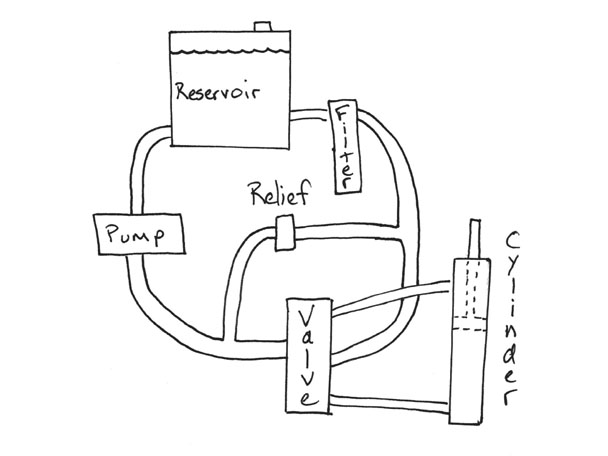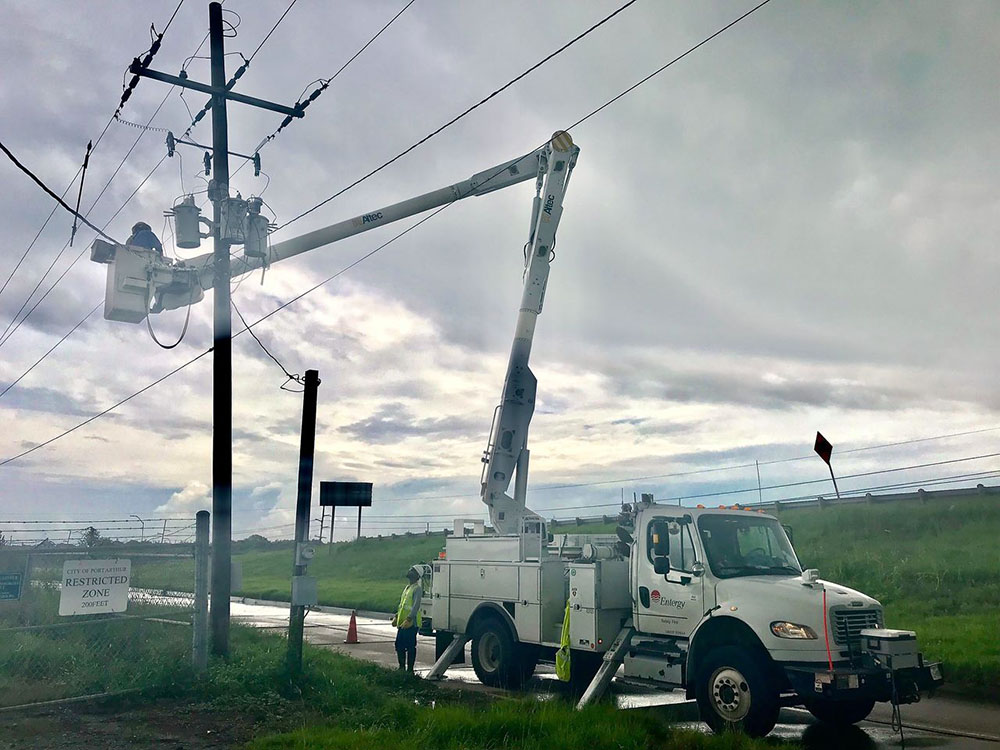Hydraulic Hoses or Systems are everywhere, you just need to know where to look. If you see orange construction barrels, then you’re also looking at equipment littered with hydraulic systems. Zero-turn lawn mower? Yep. Garbage truck? Yes, again. Brakes on your car, the tilt on your outboard motor, in a manufacturing plant...they are everywhere.
Hydraulic hoses or systems use pressurized hydraulic fluid to output work in a mechanical system. Let’s go over some quick basics. Hydraulic fluid is an oil or water based incompressible fluid. Since it is incompressible, it can efficiently transfer energy from a pump and send it to a motor or cylinder. To describe what a hydraulic system is, let’s talk about the most simple one: a log splitter. A pump pulls fluid from the reservoir through a return line and pressurizes it. The pressurized fluid is sent through a 2-wire hose and acts on a cylinder with a wedge, pushing on a log until it splits. As the piston retracts, the cylinder pushes the fluid back through a return hose into the reservoir to cool and get ready for the next cycle. This system—reservoir, pump, cylinder and hose—is the hydraulic system.

Hydraulic System
Knowing a few details about your system will help you decide what hose is right. Choosing a hydraulic hose is not that complicated once you've begun to understand the various options and why they exist.
On the one hand, there are a ton of hydraulic hose specs made by any one manufacturer. Heck, there are 19 SAE 100R specs and a handful of European EN specs. On the other, it's really pretty simple. You've essentially got three options: rubber with metal wires, thermoplastic with textile reinforcement, or Teflon with stainless braid. There are a few other application specific specs out there, and we'll talk about them in a bit, but, really, those are your three options. After you know which you need, the rest kind of sorts itself out.
Before we get started, there are some general things you need to know. First, hydraulic hose part numbers indicate inside diameter using a system of 1/16ths. For instance, -04 is 1/4'' inside diameter, or I.D. (4/16=1/4), and -12 is 1/4'' (12/16=3/4) and so on. So, a part number like H28006 is hose spec H280 and size 06, or 3/8'' I.D.
Next, hydraulic hose is usually rated based on a 4:1 safety factor. This means 3,000-psi hose bursts at 12,000 psi or more. Exceptions include jack hose which often has a 2:1 safety factor, because it is a static and low stress application. Ask our Hose Pros if you're concerned about safety factor.
The general construction of a hydraulic hose is tube, reinforcement, and cover. The tube is the inside of the hose that conveys the hydraulic fluid. Then, there is the reinforcement; this provides the strength and holds the pressure. Last is the cover. The cover's job is to protect the reinforcement from abrasion and corrosion.
Construction Types
There are three main construction types for the pressure side of a hydraulic system and one for the return side. Hoses for the pressure side of your system will usually be made of rubber, thermoplastic, or Teflon.
Rubber
Rubber hydraulic hoses are usually made of nitrile rubber since it's compatible with most hydraulic fluids. Rubber hoses can either have textile braid for lower pressure applications under 1,000 psi, or high tensile steel wire for pressures up to 7,000 psi and beyond. The wire reinforced variety is the most common. Constructions range from one layer up to six layers of reinforcement.
Covers are usually made of an engineered rubber good at withstanding the elements and abrasion. Some manufacturers produce hoses with especially tough covers for applications requiring extreme abrasion protection; these might have UHMW coatings to withstand aggressive abrasion and impact.
Thermoplastic
This construction is typically made of a nylon tube, synthetic fiber reinforcement, and a polyurethane cover. Thermoplastic hose is often used in general hydraulics, material handling, forklifts, and near electrical systems. It can handle pressures similar to 1- and 2-wire hoses but be installed in applications where a rubber hose with wire reinforcement would not work. The polyurethane cover performs very well when subjected to the abrasion of a sheave on a forklift. In situations where electricity is a concern, like in a bucket lift for repairing power lines, non-conductive, thermoplastic hose is perfect.

PTFE:
Made with a PTFE tube and stainless braid reinforcement, it does not require a cover because the stainless braid will not corrode under normal circumstances. Teflon hose is used in applications that require corrosion resistance, chemical compatibility, or where high temperature is a concern. It carries a 450°F rating.
Some things to keep in mind when specifying PTFE hose concern size and bend radius. The size is usually 1/16'' smaller than the part number indicates. For instance, -04 hose is 3/16'' and -06 is 5/16''. So, just because your part number ends in 04 does not mean the hose is 1/4''. This is true for all sizes. Regarding bend radius, remember that PTFE hose is a hard-plastic tube covered in braid. If you bend the hard-plastic tube until it kinks, you've now ruined your hose and created a weak spot. Be careful when routing in tight spaces.

Return – Hydraulic Hoses
Return line is a hydraulic hose that can handle suction and is returning the hydraulic fluid back to the beginning of the system. This style of hose is usually a rubber tube and cover with textile braid for positive pressure and a helical wire to allow for suction.
Truck Hose – Hydraulic Hoses
Truck hose is its own special category within the hydraulic hose family. SAE 100R5 defines it as a fabric cover, 1-wire hose used on many systems in on-highway vehicles. Like Teflon hose, truck hose sizing does not follow the standard 1/16th approach used by standard hydraulic hose. The actual hose ID is anywhere from a 1/16''to ⅛'' smaller depending on size. Again, call the Hose Pros at Besteflon, and we'll help you understand 100R5 hose.
This covers most of the basics of hydraulic hoses. If you ever need to dig deeper and get into the nitty gritty call one of our Hose Pros at Besteflon and we'll be happy to help.
Click the button below to request more information about PTFE hydraulic hoses.
Post time: Jan-05-2024
